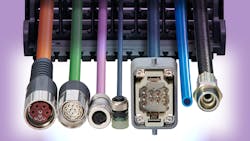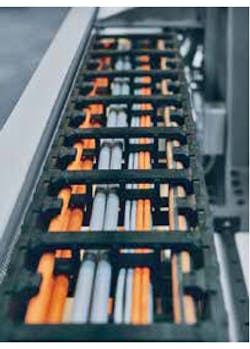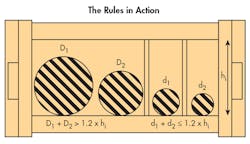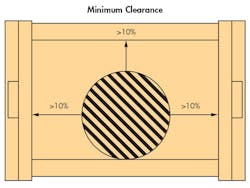2 Simple Rules for Getting the Cable Carrier Right
This file type includes high-resolution graphics and schematics when applicable.
Interior Separation
Interior separation is crucial for getting maximum service life out of cables and hoses being held in cable carriers. Cables and hoses with different diameters and outer jacket materials need to be laid out separately using modular separators. A minimum clearance between cables, hoses, and the cable carrier should also be maintained. This clearance should not exceed 1.5 times the diameter of similarly sized cables. Moreover, when a cable carrier begins to move back and forth faster and more frequently, the exact positioning of the cables and hoses inside becomes more important.
Cramming as many cables as possible into a carrier simply won’t work. Cables can become permanently deformed and “corkscrew,” or become entangled with one another. If cables with different outer-jacket materials—for example, PVC and PUR—are placed side by side, they can wear against each other and become “stuck” together or cause abrasion and damage. All of these scenarios can lead to premature failures.
The Two Essential Rules
Two key rules of distribution should always be followed when using cable carriers, so that cables and hoses move freely at all times with no tensile force exerted at the radius of the cable carrier:
Rule 1: D1 + D2 > 1.2 × hi
where D is the diameter of cable one; D2 is the diameter of cable two; and hi is the inner height of the cable carrier. Then, If D1 + D2 > 1.2 x hi, no separation is needed between the two cables/hoses. Two cables or hoses should never be left unguided on top of one another or be allowed to become entangled.
Rule 2: d1 + d2 ≤ 1.2 × hi
If d1 + d2 ≤ 1.2 x hi, a vertical separator or a horizontal shelf must be used to reduce the inner height, thereby preventing the two cables from getting entangled.
Here are some other guidelines for distribution:
• The cumulative weight of the cables and hoses should be evenly distributed across the width of the chain.
• No more than two cables or hoses should be installed on top of one another.
• Cables and hoses should always be strain relieved at the moving end and, whenever possible, at both ends. The exception is that hydraulic hoses should only be strain relieved at the moving end.
• For high-speed applications (travel speed over 1.64 fps) and high cycles (10,000 annually), cables or hoses must not be laid on top of one another without horizontal separation.
Dan Thompson is Product Manager for energy chain systems at igus Inc., East Providence, R.I.





